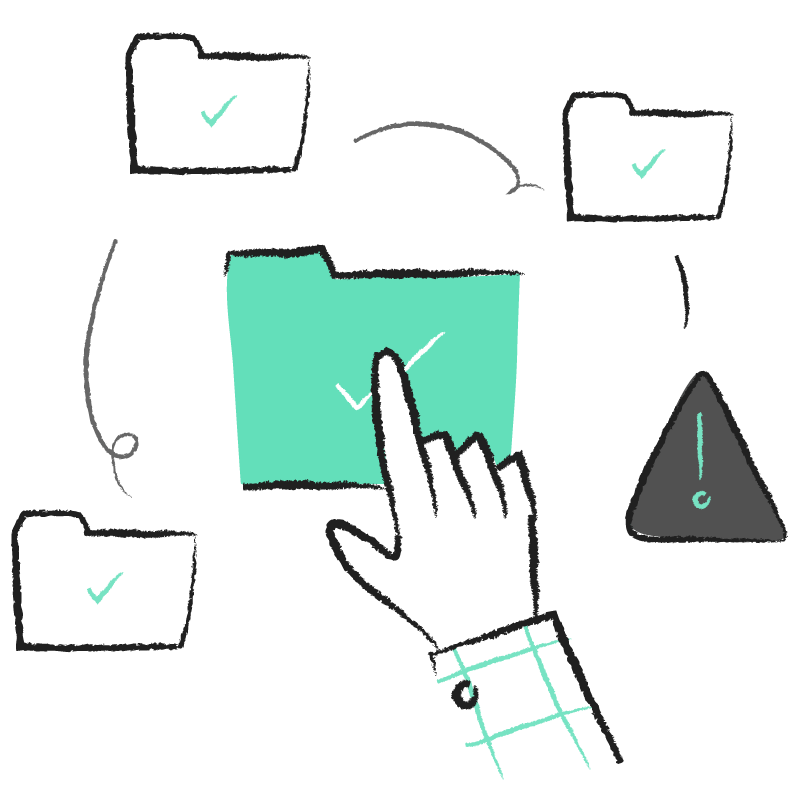- What is privileged account management?
- What is a privileged account?
- Types of privileged accounts
- Why is privileged account management important for enterprises?
- Business benefits of privileged account management
- Essential capabilities of a privileged account management tool
- How does privileged account management work?
- Best practices for effective privileged account management
- Why Password Manager Pro should be your go-to privileged account management solution
Privileged account management deals exclusively with the protection of privileged accounts in an enterprise, including those of operating systems, databases, servers, applications, virtual machines, and networking devices.
What is a privileged account?
A privileged account is any account that has higher privileges associated with it than other accounts. These accounts could be owned by humans like an organization's employees, third-party collaborators such as vendors and auditors, or these could be machine identities such as a service account, a workload, or an application.
Types of privileged accounts.
- 01
Local/built-in administrator accounts are accounts on member servers and clients that grant absolute control over their hosts. This also includes the default login accounts that come built-in with operating systems, application software, and services. If local administrator passwords are weak, left unchanged, or repeatedly used on multiple accounts across hosts, malicious users could easily gain unauthorized access to workstations. In the worst-case scenario, an attacker with access to a local admin account or a forgotten built-in system account could navigate across the network and even elevate their privileges to that of a domain administrator.
-
02
Domain administrator accounts are powerful accounts with the widest range of control over every object in a domain. These accounts provide administrative privileges on all workstations, servers, and domain controllers. Only a few, trusted administrators should use domain administrator accounts. Moreover, they should only use the account to log on to the domain controller systems that are as secure as the domain controllers themselves, especially in a Windows ecosystem.
-
03
Administrative service accounts are privileged accounts used by system programs to run application software services or processes. At times, these accounts may possess high or even excessive privileges when a certain dependent service requires it. This also goes for local or domain Windows accounts used to run Scheduled Tasks. Typically, such service account passwords are set to "never change," due to the difficulty in discovering all dependent services and propagating the password change, which could, in turn, delay business service continuity. However, static service accounts can make your enterprise an easy target for hackers.
-
04
Root accounts are superuser accounts that carry administrative privileges to manage Unix/Linux resources, which are typically used by system administrators to perform core IT operations. Root accounts have unrestricted access to all files, programs, and other data on a system, and therefore pose an enormous risk when mismanaged.
-
05
Application accounts are accounts used by organizations to automate communication between various applications, web services, and native tools to fulfill business and other transaction requirements. Application credentials are usually embedded in clear text within unencrypted application configuration files and scripts to achieve this business communication interfacing.
-
06
Embedded application accounts are used in many DevOps environments where credential hard-coding is commonly followed to expedite software development phases and automate service delivery cycles. Administrators usually find it difficult to identify, change, and manage these passwords. As a result, the credentials are left unchanged, which makes them an easy entry-point for hackers.
Why is privileged account management important for enterprises?
Because a privileged user account in the wrong hands is a deadly weapon that can easily bring down an enterprise. Lax management of privileged user accounts can expose enterprises to the following security risks:
-

Exploitation of unsuspecting employees by attackers
Privileged user accounts are a favorite among attackers looking to gain full access to sensitive data servers without attracting suspicion. Once inside, hackers immediately prowl around for unmanaged privileged credentials and escalate themselves to domain administrator status, which provides them with unrestricted access to highly sensitive information systems.
-
Privilege abuse by rogue insiders
At times, the biggest threats are the ones that are closer to home. Likewise, insider privilege misuse is a rapidly growing concern today in organizations of all sizes. Internal privileged users with the wrong intentions for personal gain can cause more damage than external parties. The inherent trust placed in insiders enables them to take advantage of their existing privileges, siphon off sensitive data, and sell it to a external party without getting noticed until it is too late.

-

Malicious practices by negligent employees
Careless employees are a difficult threat to manage without proper privileged access management. These are users who do not understand the significance of cybersecurity. They recklessly leave critical user credentials lying around for hackers to find, or sometimes share their access privileges with unauthorized employees. A typical example is DevOps engineers dumping their codes (which contain authentication tokens for internal servers) on open platforms like GitHub and forgetting about them.
-
Remote vendors and ex-employees abuse their privileges
Remote vendors make up the extended business network of an organization. They usually include contractors, consultants, partners, third-party maintenance teams, and service providers who require privileged access to your internal infrastructure for a variety of business needs. Almost every organization depends on multiple contractors to get work done. In today's digital world, this means third-parties have access to your internal network for business requirements, and therefore pose as equal a threat as insiders.

-

More privileges than necessary
More often than not, users are over-privileged, i.e. they have access rights that are far more than what they need to perform their job duties. As a result, there is a gap between granted permissions and used permissions. In such instances, it's important to apply the principle of least privilege—providing only the minimum required permission to complete a work task. Without a proper privileged access management system to enforce least privilege security and monitor user actions, over-privileged user accounts can be leveraged for illegitimate access.
-
Privileges, once granted, are never rescinded
Forgotten privileges are dangerous. IT administrators often provision users with privileged access to data servers and then fail to revoke them. Without a tool to track who has been given what privileges, retracting permissions can be a cumbersome task. This means users continue to hold privileges even after their job is done, and they have the opportunity to execute unauthorized operations.

Business benefits of privileged account management
Following are the cybersecurity benefits that a robust privileged account management solution delivers:
-
Centralized management
Take complete control of privileged accounts by storing them in a secure repository with a single access point fortified with multi-factor authentication.
-
Reduced risk exposure
Shrink the attack surface and effectively combat growing risks of external attacks, identity theft, and insider threats.
-
Improved incident response
Establish preventive and detective security controls through approval workflows and real-time alerts on privileged accounts usage.
-
Enhanced security and compliance
Effectively prove compliance with various industry and government regulations, like HIPAA, PCI DSS, the GDPR, NERC-CIP, SOX etc.
-
Increased visibility
Acquire a comprehensive overview of privileged account activity across the network with extensive audit logging and informative reports.
-
Cybersecurity automation
Boost IT productivity by discharging IT teams of time-consuming manual tasks such as bulk password updates through automation schedules.
Essential capabilities to look for while choosing the right privileged account management software for your organization
Privileged accounts−owing to their value, will continue to be a prime target of cybercriminals. Thus, while searching for potential privileged account management solutions, organizations should look at the process as a long-term cybersecurity investment instead of a stopgap arrangement. When evaluating and appraising solutions to find the perfect privileged account management solution for your business, there is a predetermined set of key features that dictates the effectiveness and eventual success of your organization's privileged account protection program.
Following are the capabilities to look for during the selection process.
Feature checklist
Key focus areas to look for in a robust privileged account management solution
- Centralized credential vault
- Automated discovery of IT assets and privileged accounts
- Web-based access with a simple, easy-to-use interface
- Strong data encryption during transit and at rest
- Robust user authentication such as AD/LDAP, RADIUS, SAML, smart card and more
- Multi-factor authentication for vault access such as TOTP, YubiKey, and Duo Security
- Fine-grained, role-based access to stored privileged accounts
- Selective sharing with varying access privileges
- Approval workflows with dual controls and ticket ID validation for release of privileged credentials
- Time-limited access to passwords and SSH keys
- Just-in-time controls
- Notifications or alerts on credential checkouts and checkins
- Secure APIs to enable application-to-application communications for automated credential checkouts
- Periodic credential rotation schedules
- Wide platform support including legacy systems, cloud services, DevOps tools, business applications, IoT devices, and robotic process automation services
- Pre-built password/SSK key policies of varying strengths
- Built-in password and key generator
- Enforced usage of strong passphrases and keys
- Extensive audit logging module
- Interactive, customizable reports on privileged account activity, password compliance, access status etc.
- Out-of-the-box (OOTB) regulatory compliance reports for PCI DSS, SOX, NERC CIP and more
- Report scheduler
- OOTB integration capabilities for ticketing systems and SIEM tools
- Break glass provisions
- High availability and fail over service for uninterrupted access to privileged accounts of critical systems
- AI/ML-powered anomaly detector to catch unusual access to privileged accounts at non-business hours
How does privileged account management work?
Privileged account management is a subset of IAM. Privileged account management safeguards accounts with elevated access through a combination of centralized management, enforcing least privilege, implementing multi-factor authentication and access controls, monitoring sessions, using just-in-time provisioning, and automating tasks, ultimately minimizing the risk associated with these powerful accounts.
Beyond technical controls, privileged account management emphasizes robust governance with clear ownership and accountability for privileged accounts. Regular training for authorized users on secure access practices further strengthens the defense. By continuously monitoring and auditing privileged activity, organizations can identify and address potential misuse or anomalies promptly. It not only bolsters security but also streamlines IT operations, allowing authorized users to perform critical tasks efficiently while minimizing disruptions.
Best practices for effective privileged account management
- Maintain a complete list of all active privileged accounts in your network, and update that list whenever a new account is created.
- Store privileged identities like passwords, SSH keys, and SSL certificates in a secure vault using standardized encryption algorithms such as AES-256.
- Enforce stringent IT policies that cover password complexity, frequency of password resets, strong SSH key pairs generation, time-limited access to privileged accounts, automatic reset upon one-time use, and other robust controls.
- Share the privileged accounts with employees and third-party users in a secure way, such as granting privileged access with the minimal permissions required to carry out the job.
- Audit all identity-related operations, such as privileged user logins, password shares, password access attempts, reset actions, and so on.
- Monitor and record all privileged user sessions and activities in real time.
Why Password Manager Pro should be your go-to privileged account management solution
ManageEngine Password Manager Pro is a web-based privileged account management solution tailored for enterprises. The solution allows you to store, share, manage, monitor, and audit the life cycle of any privileged account in your organization. With a range of features, such as account discovery, strong vaulting mechanisms, granular access controls, automated password resets, SSL certificate life cycle management, user activity auditing, and secure remote access—all built into a single platform, Password Manager Pro is the one solution you need to ensure privileged account security in your IT environment.
FAQs on privileged account management
-
What is the difference between privileged account management and privileged access management?
Privileged account management focuses on managing privileged accounts and their passwords, while privileged access management encompasses the broader controls around how those accounts are accessed and used.
-
Why is managing privileged accounts important, and what happens if we don't?
Managing privileged accounts is crucial to prevent unauthorized access, data breaches, and system disruptions. Unmanaged privileged accounts become easy targets for attackers, potentially compromising critical data and crippling operations.
-
What is the difference between PAM and IAM?
Identity and access management (IAM) is a security framework for identifying, authenticating, and providing access to users. IAM consists of special policies, controls, and solutions to manage identities in an enterprise. IT managers leverage an IAM solution to control access to databases, assets, networks, applications, and resources within their organization. Typically, IAM applies to all users in an organization.
While privileged access management (PAM) is a subset of IAM that deals only with managing privileged access. PAM mainly pertains to privileged users who have elevated access to sensitive resources, applications, and accounts. PAM focuses on users and accounts that pose a higher security threat and data breach risk by having privileged access. IT admins use a PAM solution to track, audit, and manage privileged users, identities, accounts, and sessions.
-
What is the difference between PAM and PIM?
Privileged identity management (PIM), is a subset of PAM that deals with essential security controls and policies limited to managing and securing privileged identities, such as service accounts, usernames, passwords, SSH keys, and digital certificates, that provide access to sensitive information.
PAM has a broader scope that stretches beyond just managing privileged identities. PAM focuses on governing the access levels of users with privileged credentials, and determines which users can access which resources and for how long.